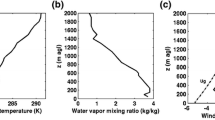Abstract
Some important diagnostic characteristics for a model’s physical background are reflected in the model’s energy transport, conversion, and cycle. Diagnosing the atmospheric energy cycle is a suitable way towards understanding and improving numerical models. In this study, formulations of the “Mixed Space-Time Domain” energy cycle are calculated and the roles of stationary and transient waves within the atmospheric energy cycle of the Global-Regional Assimilation and Prediction System (GRAPES) model are diagnosed and compared with the NCEP analysis data for July 2011. Contributions of the zonal-mean components of the energy cycle are investigated to explain the performance of numerical models.
The results show that the GRAPES model has the capability to reproduce the main features of the global energy cycle as compared with the NCEP analysis. Zonal available potential energy (AZ) is converted into stationary eddy available potential energy (ASE) and transient eddy available potential energy (ATE), and ASE and ATE have similar values. The nonlinear conversion between the two eddy energy terms is directed from the stationary to the transient. AZ becomes larger with increased forecast lead time, reflecting an enhancement of the meridional temperature gradient, which strengthens the zonal baroclinic processes and makes the conversion from AZ to eddy potential energy larger, especially for CAT (conversion from AZ to ATE). The zonal kinetic energy (KZ) has a similar value to the sum of the stationary and transient eddy kinetic energy. Barotropic conversions are directed from eddy to zonal kinetic energy. The zonal conversion from AZ to KZ in GRAPES is around 1.5 times larger than in the NCEP analysis. The contributions of zonal energy cycle components show that transient eddy kinetic energy (KTE) is associated with the Southern Hemisphere subtropical jet and the conversion from KZ to KTE reduces in the upper tropopause near 30°S. The nonlinear barotropic conversion between stationary and transient kinetic energy terms (CKTE) is reduced predominantly by the weaker KTE.
Similar content being viewed by others
References
Arpe, K., C. Brancovic, E. Oriol, et al., 1986: Variability in time and space of energetics from a long series of atmospheric data produced by ECMWF. Beitr. Phys. Atmos., 59, 321–355.
Dickinson, R. E., 1969: Theory of planetary wave-zonal flow interaction. J. Atmos. Sci., 26, 73–81.
Gao Hui, Chen Longxun, He Jinhai, et al., 2006: Characteristics of zonal propagation of atmospheric kinetic energy at equatorial region in Asia. Acta Meteor. Sinica, 20, 86–94.
Huang, H.-J., and D. G. Vincent, 1988: Daily spectral energy conversions of the global circulation during 10–27 January 1979. Tellus, 40A, 37M9.
Kung, E. C., 1988: Spectral energetics of the general circulation and time spectra of transient waves during the FGGE year. J. Climate, 1, 5–19.
Lau, N. C., and A. H. Oort, 1982: A comparative study of observed Northern Hemisphere circulation statistics based on GFDL and NMC analyses. Part II: Transient eddy statistics and the energy cycle. Mon. Wea. Rev., 110, 889–906.
Li Qingquan and Zhu Qiangen, 1995: Analysis on the source and sink of kinetic energy of atmospheric 30–60-day period oscillation and the probable causes. Acta Meteor. Sinica, 9, 420–431.
Lorenz, E. N., 1955: Available potential energy and the maintenance of the general circulation. Tellus, 7, 157–167.
Luo Zhexian, 1994: Effect of energy dispersion on the structure and motion of tropical cyclone. Acta Meteor. Sinica, 8, 51–59.
Oort, A. H., 1964: On estimates of the atmospheric energy cycle. Mon. Wea. Rev., 92, 483–493.
—, 1983: Global Atmospheric Circulation Statistics 1958–1973, Volume 14, NOAA Professional Paper. U.S. Department of Commerce/NOAA, 180.
Simmons, A. J., and B. J. Hoskins, 1978: The life cycles of some nonlinear baroclinic waves. J. Atmos. Sci., 35, 414–432.
—, and —, 1980: Barotropic influences on the growth and decay of nonlinear baroclinic waves. J. Atmos. Sci., 37, 1679–1684.
Stein, C., 1986: Das zeitliche Zusammenwirken baroklinerEnergieumwandlungen durch grogrfiumige Wellen in derAtmosph/ire. Diplomarbeit, Institut fiir Geophysik und Meteorologie der Universit/it zu K61n.
Steinheimer, M., M. Hantel, and P. Bechtold, 2008: Convection in Lorenz’s global energy cycle with the ECMWF model. Tellus, 60A, 1001–1022.
Stone, P. H., 1978: Baroclinic adjustment. J. Atmos. Sci., 35, 561–571.
Storch, J. S., C. Eden, and I. Fast, 2012: An estimate of the Lorenz energy cycle for the world ocean based on the STORM/NCEP simulation. J. Phys. Oceanogr., 42, 2185–2205.
Ulbrich, U., and P. Speth, 1991: The global energy cycle of stationary and transient atmospheric waves: Results from ECMWF analyses. Meteor. Atmos. Phys., 45, 125–138.
Wu Rongsheng, 1987: Energy, energy flux and Lagrangian of Rossby wave. Acta Meteor. Sinica, 1, 143–150.
Author information
Authors and Affiliations
Corresponding author
Additional information
Supported by the National Nature Science Foundation of China (41305091) and China Meteorological Administration Special Fund for Numerical Prediction (GRAPES).
Rights and permissions
About this article
Cite this article
Zhao, B., Zhang, B. Diagnostic study of global energy cycle of the grapes global model in the mixed space-time domain. J Meteorol Res 28, 592–606 (2014). https://doi.org/10.1007/s13351-014-3072-0
Received:
Accepted:
Published:
Issue Date:
DOI: https://doi.org/10.1007/s13351-014-3072-0




